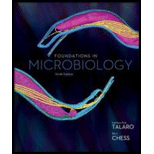
1. Biologists can set up an ecosystem in a small, sealed aquarium that continues to function without maintenance for years. Describe the minimum biotic and abiotic components it must contain to remain balanced and stable.
To determine:
The minimum abiotic and biotic components required to maintain a balanced and stable sealed aquarium for years.
Introduction:
To maintain a balanced and stable sealed aquarium, it has to act like an aquatic ecosystem. It should contain the adequate and required abiotic and biotic components. A sealed aquarium ay be thought of as a mini lake and hence a similar kind of ecosystem needs to be created.
Explanation of Solution
The concept of creating is a sealed aquarium is similar to making a nature aquarium. The major requirements are primary producers, consisting of phytoplankton, algae and diatoms. Consumers such as zooplanktons, small and large fishes are required and decomposer microbes are must. There should be appropriate amount of sunlight or artificial light that can help in photosynthesis along with supply of oxygen and carbon dioxide. An artificial bedrock also needs to be created.
Hence, it may be concluded that, an artificial sealed aquarium needs appropriate abiotic and biotic components.
Want to see more full solutions like this?
Chapter 26 Solutions
Foundations in Microbiology
- The natural residence of every organism is known as: 1.Biome 2.Niche 3.Habit 4.Habitatarrow_forwardQuestions 1 What was the impact of overfishing on the community of fishers? What was the impact of fishers invading the ocean used by other communities? 2 How does this activity relate to real fisheries and ocean issues? 3 What does the following quote mean? "In the end, our society will be defined not only by what we create, but by what we refuse to destroy." - John Sawhill, former President of the Nature Conservancy 4 How does this quote relate to fisheries? 5 What factors have not been included in this activity that impact real fisheries? 6 What happens to a resource when demands are high, so new technologies are introduced to increase efficiency, but the resource is finite? Explain. 7 How can a sustainable fishery be developed? What limitations should exist? How should it be regulated? 8 What are other commonly held resources, besides fisheries? What are issues that surround them? How can they best be managed?arrow_forward5. The organisms used as examples in this activity are common in lake and river ecosystems in North America. Using the information below construct a food web of a typical lake ecosystem in the space provided below. • Algae undergo photosynthesis • Zooplankton eat algae • Minnows eat zooplankton, algae and insect larvae • Largemouth bass eat sunfish and minnows • Sunfish eat minnows and insect larvae • Osprey eat largemouth bass • Insect larvae eat zooplankton and algae • Snapping turtles eat minnows and sunfisharrow_forward
- 1.What single factor has the greatest effect on how much water a person uses (i.e. how much does one use on a daily or annual basis)? 2.When studying aquatic ecosystems why is it important to understand physical (abiotic) aspects of the environment.arrow_forward1. Why does disturbance is an important positive ecological process? Discuss it briefly and cite an example. Explain it thoroughly and do not just copy from somewhere, please.arrow_forwardBiotic factors are the living factors that affect living organisms, they include • Availability of food • Pathogens and parasites New predators Interspecific competition • Write a sentence for each of these factors explaining the consequences of them on living organisms chances of survivalarrow_forward
- 11. The following is a list of abiotic factors that would have a micro-effect on a tidal pool (rocky pockets of water where the ocean meets the land). Select the one that would have larger, long-term effects if changed.(1 point) rising water depth water chemistry (pH, pollution, etc.) weather (wind, rain, etc.) temperature 9. A graph of the total number of species found in an area against the percentage of land under protection would show a/an(1 point) exponential correlation. lack of correlation. positive correlation. negative correlation.arrow_forward4. Explain how abiotic factors regulate population abundance. Describe what kinds of abiotic factors regulate populations. Give an example.arrow_forwardWhich of the following is not an abiotic factor in an ecosystem? A) Available light B) Temperature Water availability Number of organisms in a populationarrow_forward
- 1st picture : Backyard Garden ( bees suck honey from the flowers ) 2nd picture : Drain ( tadpoles and mosquito larvae ) Picture biotic components abiotic components 1st trees, grass air, soil 2nd microbes, insects rock, air Explain each abiotic and biotic factors in each ecosystems.arrow_forward2. Give an example in your daily activities that illustrates each level of organization of ecological importance Hint: read first about hierarchical/levels of organization in ecologyarrow_forward1. Billy is stranded on an island. He has unlimited access to water, six chickens, and a few bags of corn. He is considering his options for how to survive on the island until he is rescued. Draw a model of the food web and the trophic pyramid on the island for each of these three options. Option A: Feed all the corn to the chickens and eat their eggs. Trophic Pyramid Food Web Option B: Share the corn with the chickens. Eat their eggs, then eat the chickens when the corn runs out. Food Web Trophic Pyramid Option C: Eat the chickens first, then eat the corn. Food Web Trophic Pyramidarrow_forward
